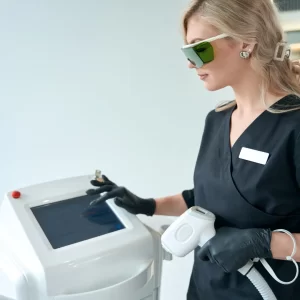Laser hair removal stands out as one of the most sought-after cosmetic procedures in today’s beauty landscape, offering a long-term solution to unwanted hair.
This technology targets hair follicles with laser light, damaging them to reduce hair growth significantly over time.
While the allure of smooth, hair-free skin drives many to opt for this treatment, a common question arises:
How many sessions are required to achieve optimal results? Understanding the number of sessions needed is crucial for setting realistic expectations and planning both time and budget accordingly.
The answer, however, is not one-size-fits-all.
It varies depending on several factors, including the area being treated, hair density, and individual hair growth patterns.
This article delves into the nuances of laser hair removal, aiming to provide a comprehensive overview of what one can expect in terms of session requirements for achieving the best possible outcomes.
Understanding Laser Hair Removal
Laser hair removal is a procedure that uses concentrated light to target and damage hair follicles, which are responsible for hair growth.
The laser emits a light that is absorbed by the pigment (melanin) in the hair.
This light energy is then converted to heat, which damages the tube-shaped sacs within the skin (hair follicles) that produce hairs.
This damage inhibits or delays future hair growth.
How It Works
The process relies on the principle of selective photo thermolysis, which ensures that the laser targets only the hair follicle while sparing the surrounding skin.
For effective hair removal, the laser needs to catch the hair in a growth phase (anagen phase), when it’s most susceptible to treatment because it’s actively producing hair.
However, not all hairs are in this phase at the same time, which is why multiple sessions are required to catch as many hairs in the anagen phase as possible over time.
Factors Affecting Effectiveness
- Hair Color and Skin Type: The best candidates for laser hair removal have dark hair and light skin because the laser targets the melanin (color) in the hair. However, advances in technology have made it possible for people with darker skin tones and those with lighter hair to also see effective results, albeit potentially requiring more sessions.
- Type of Laser: Different types of lasers are used based on skin and hair type. For example, the Alexandrite laser is typically more effective for light to olive complexions, while the Nd:YAG laser is better suited for darker skin tones.
Average Number of Sessions Required
While the procedure has been refined over the years, the number of sessions needed for optimal results can vary significantly from person to person.
On average, most individuals require between 6 to 8 sessions to achieve substantial hair reduction.
Variability Among Individuals
Body Area: Certain areas of the body respond more quickly to laser hair removal than others. For instance, the face may require more sessions compared to the legs due to hormonal influences and differences in hair growth cycles.
Individual Response: Factors such as hair density, color, and the individual’s hormonal balance can affect how many sessions are needed. Those with thicker, denser hair may find they need additional sessions for complete coverage.
Factors Influencing the Number of Sessions
The variability in session requirements can be attributed to several individual-specific factors, including:
- Hair Thickness and Color: Thicker, darker hairs absorb more laser energy and are often treated more effectively in fewer sessions than thinner, lighter hairs.
- Area Being Treated: Areas with denser hair growth, such as the bikini line, may require more sessions than areas with thinner hair, like the arms.
- Hair Growth Cycles: Hair growth occurs in cycles, and laser hair removal is most effective during the anagen (growth) phase. Since not all hairs are in the same phase at the same time, multiple sessions ensure that hairs are targeted at the optimal time in their growth cycle.
The process of laser hair removal, therefore, necessitates a personalized approach, taking into account these individual factors to estimate the number of sessions required accurately.
Moving forward, we’ll explore the importance of maintenance sessions and how to maximize the results of your treatment.
Maintenance Sessions
After completing the initial series of laser hair removal sessions, many individuals experience significant hair reduction.
However, some hairs may eventually regrow due to hormonal changes or the activation of previously dormant hair follicles.
Maintenance sessions play a crucial role in managing this regrowth and maintaining smooth, hair-free skin over time.
Why Maintenance Sessions Are Necessary
- Hormonal Changes: Changes in hormone levels, such as those occurring during pregnancy, menopause, or due to conditions like polycystic ovary syndrome (PCOS), can stimulate new hair growth. Maintenance sessions help in targeting these newly active follicles.
- Dormant Hair Follicles: Not all hair follicles are active at the same time. Some may enter the growth phase after the initial treatment series, necessitating additional sessions to achieve comprehensive results.
Typical Frequency of Maintenance Treatments
The frequency of maintenance treatments varies widely among individuals, but most find that 1 to 2 sessions per year are sufficient to keep hair growth at bay.
Your practitioner can provide personalized advice based on how your hair responds to the treatment over time.
Maximizing Results
To ensure the best possible outcomes from laser hair removal, it’s important to follow pre-treatment and post-treatment care instructions closely.
These guidelines help prepare your skin and hair for the procedure and aid in recovery and hair reduction efficacy.
Pre-Treatment Care
- Avoid Sun Exposure: Sun-tanned or sunburned skin can complicate the laser hair removal process. Avoid sun exposure and tanning beds for at least 2 weeks before treatment.
- Shave the Area: Shaving the treatment area 24 hours before your session can enhance the laser’s ability to target the hair follicles effectively. Avoid waxing or plucking, as these methods remove the hair from the follicle, making laser treatment less effective.
Post-Treatment Care
- Soothe the Skin: Apply aloe vera or a cooling gel to soothe any temporary redness or discomfort in the treated area.
- Protect from Sun Exposure: Use a broad-spectrum SPF 30 or higher sunscreen on the treated areas, especially if they’re exposed to the sun, to prevent skin damage and ensure uniform results.
Conclusion
Laser hair removal offers a promising solution for those seeking to reduce unwanted hair growth.
While the number of sessions required can vary widely based on individual factors such as hair color, thickness, and the area being treated, most individuals can expect to undergo 6 to 8 sessions for optimal results.
Maintenance sessions are also a critical component of sustaining these results over time.
Understanding the factors that influence the treatment’s effectiveness and adhering to pre and post-care instructions can significantly enhance the outcomes.
However, it’s essential to consult with a qualified professional to receive a tailored treatment plan that considers your unique characteristics and goals.
Embracing this personalized approach will pave the way for achieving the smooth, hair-free skin that laser hair removal promises.









